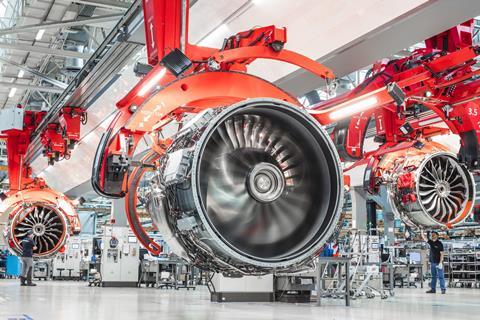Safran sees continued momentum in the industry’s recovery from the Covid-19 downturn as the French aerospace giant reported a robust performance in the third quarter.
Revenue for the three months ended 30 September stood at €3.7 billion ($4.3 billion), a 10.4% year-on-year increase and a 5.7% rise over the previous quarter.

“Safran’s third-quarter revenue confirms that the recovery is gaining strength month after month, which makes us optimistic for the future,” says chief executive Olivier Andries.
“We are efficiently managing the business recovery in terms of costs, supply chain and inventories which will enable Safran to emerge stronger from this crisis.”
Group revenue for the nine months was down 9.3% against 2020 at €10.6 billion, mainly due to the strong performance in the first quarter of last year which was unaffected by the coronavirus crisis. Safran anticipates a strong fourth quarter this year, says Andries.
Safran points to a recovery in air traffic through the summer season – notably in Europe and North America – although it acknowledges that the rebound is occurring at a different pace in other regions.
Improving utilisation rates of single-aisle jets are a key metric to the company thanks to its interest in the CFM International narrowbody engine joint venture with GE Aviation. However, data suggests that the rebound is being led by the newer-generation Leap-series engines which power the Airbus A320neo and Boeing 737 Max families.
Safran says that, as of the week of 17 October, weekly flight cycles of Leap-series engines were up 105% against the same period in 2019, an increase against the 101% recorded at 18 July.
However, recovery of the CFM56 fleet continues to lag: it was 31% down against the same week a year earlier, albeit this was a slight improvement over the 35% reduction seen in July.
At the end of September, combined shipments of CFM56 and Leap engines stood at 704 units, compared with 745 in the same period a year earlier.
But that decrease across the nine months is largely due to the planned ramp-down in CFM56 production, falling to 79 this year from 123 in the same period of 2020.
Leap output meanwhile stayed steady at 625 units, a tiny increase on the 622 shipped in the first nine months of 2020. However, Leap deliveries were significantly up in the quarter, rising to 226 from 172 in the same period last year.
Revenue for the aerospace propulsion unit, which also includes helicopter and military engines, stood at €1.8 billion for the quarter, up 16.2% year on year, mainly driven by the performance of its services business.
Nine-month revenue was €5 billion, down 9.7% against the same period in 2020, largely due to lower volumes of CFM56 and of the high-thrust engines in which it has an interest.
Quarterly revenues in Safran’s aircraft equipment and interiors divisions also nudged higher, increasing by 5.1% and 7.8% respectively, largely on the back of improving services income which compensated for lower original equipment sales due to lower rates at Airbus and Boeing.
Those production cuts have been keenly felt in the interiors business, where revenues for the nine-month period were 27.9% lower year on year, or 23.6% lower when a business disposal is discounted.


























